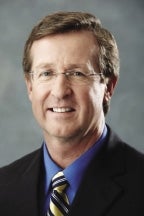It's all about efficiency, cost savings
 Michael D. Grimmer: Energy use is one of the few controllable costs at hospitals.
Michael D. Grimmer: Energy use is one of the few controllable costs at hospitals.
In recent years, health care providers throughout Massachusetts have been forced to become fiscally creative as they maneuver through the maze of decreasing government payments and cost-cutting pressures. Those hit hardest tend to be smaller community hospitals that provide critical services to hard-to-reach communities.
Hospital CEOs are challenged to balance budgets amid costs, such as staffing, equipment and services, while ensuring the doors stay open, especially in times of crisis. The unfortunate results are often unit closures and staff cuts.
I understand the importance of maintaining top-notch services since, in my role, I must ensure facilities are operating at peak efficiency to avoid wasting money in one of our few controllable costs: energy use. The more efficiently we operate, the more money the hospital saves and can put toward serving patients.
Massachusetts hospitals are taking a critical look at their energy use, and employing innovative technologies to reduce their impact on the electricity grid and increase their resiliency against extreme weather patterns that are typical of New England.
Helped by government incentives and expert advice from utilities, health care facilities are already upgrading lighting systems, boilers and other facilities equipment. Heywood, for example, has been able to save more than $500,000 annually.
But what's next? After the lightbulbs are changed and the boilers upgraded, how can a facility become more resilient and efficient to maximize savings and operations?
Health care facilities around the state are looking at opportunities to employ combined heat and power (CHP) systems. CHP generation is a well-established technology for producing both electricity and heat directly on site rather than relying on the grid.
Heywood is building on its energy efficiency program and has started to design a cogeneration power plant, from which we will generate hot water and electricity simultaneously from one energy source. We're also beginning the installation of a 1-megawattsolar panel array covering the parking area. Together, these two technologies will generate up to 60 percent of the hospital's energy needs, reducing our load on the grid. These projects are moving forward thanks to the cost savings we've achieved so far with our energy efficiency measures, and state and federal incentives.
Like Heywood, other Massachusetts hospitals are deploying CHP to support other goals, such as:
• Avoiding peak demand charges from utilities;
• Substantially mitigating green house gas emissions; and
• Reducing pollutant emissions that impact the health of local residents.
At Heywood, we consider these resiliency investments as important as any other. Not only are the cost savings very important, but by independently generating energy, we can keep our facility up and running when our community needs us most. Our region is no stranger to extreme weather events: tornadoes, blizzards, hurricanes; we've seen it all. We cannot do our job when our power is out. But by controlling our energy use and generation, we're building resiliency measures that will ensure we can serve our community at all times.
Michael D. Grimmer is vice president for support services at Heywood Hospital and chief operating officer at Athol Hospital.









0 Comments